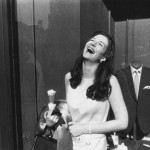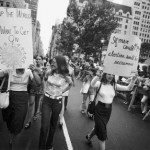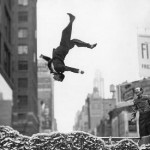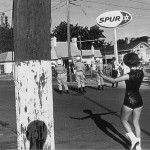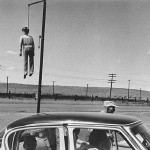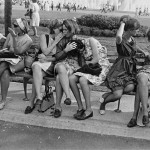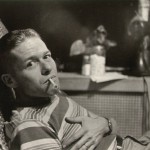Garry Winogrand was born in New York City in 1928; he became interested in photography in the late 1940’s when he was in the United States Air Force. When he was done his term of duty, he went on to City College in New York City to study painting. A year later he went to Columbia University to study both painting and photography. There he met George Zimbel, a student and photographer for the Columbia Spectator, the university newspaper. Zimbel introduced Garry to the darkroom in the college, which was open twenty-four hours a day. This was the first time Garry had been exposed to the process of photography, and it amazed him. Within two weeks, he dropped his painting classes. Winogrand started off experimenting with Graphlex, Rolleicord, and Kodak 35, but had a better love for the Leica.
He lived with his parents in the Bronx, during the two-year period when his photography didn’t gain him any income. By the early 1950’s 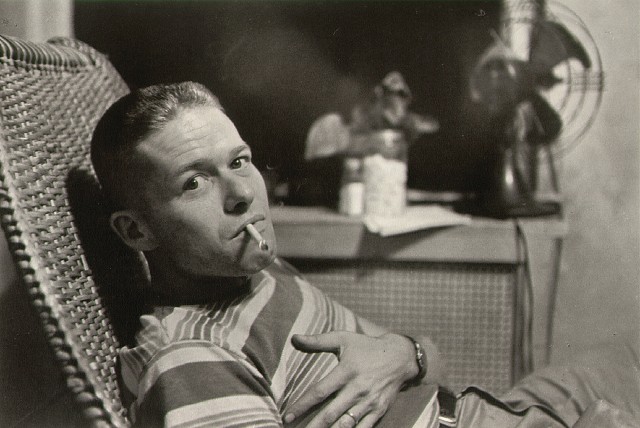 Winogrand was taken on as a stringer (a freelance photographer) for the Pix agency, where his friend George Zimbel was also working.
Winogrand was taken on as a stringer (a freelance photographer) for the Pix agency, where his friend George Zimbel was also working.
The people at Pix recommended Winogrand to the photographer representative Henrietta Brackman. Winogrand arrived at his interview with Brackman with four piles of prints that reached from floor to desktop. During the mid-fifties Collier’s, Argosy, Pageant, Redbook, Men, Gentry, Climax and Sports Illustrated published Winogrand’s pictures.
Winogrand’s work was still formed completely by his own insightful response to work in the magazines. He was uneducated in the history of photography and the history of much else. Photography was a kind of magic for which he had a taste and a talent. It is not clear that he ever then considered the question of whether it was useful.
Late in 1955 Winogrand made his first independent excursion across the country, because of a vague sense that there were pictures to take out there. When Winogrand’s friend found out about his adventure, he showed him Walker Evan’s book American Photography, someone who Winogrand was not familiar with. When he looked at Evan’s photos, he for the first time understood that photos had understanding and intelligence, other than just viewing pleasure.
In the same year Robert Frank began a cross-country trip that produced the pictures for his enormously influential book The Americans. Winogrand once again did not know Frank’s work, but like Evans’s he was deeply impressed.
In the early 1960’s, Winogrand had begun to photograph women on the street. The subject remained a major preoccupation for several years. Winogrand’s view on women was conceivably shocking, yet simple and enthusiastic. However awkward, Winogrand’s pictures of women in public places mostly made during the sixties, wasn’t published until 1975, as Women Are Beautiful. Winogrand thought his view of woman would be a commercial success, due to the rest of the male world. Too much of his disappointment, the book was not much of a success. In general, woman disliked the book and men were mystified by it, demonstrating that an artist’s enthusiasms can muddle even the most basic of issues. Many critics of Winogrand thought his book to be shapeless as a whole and the pictures uneven in quality. Even Winogrand himself thought it to be the weakest of his books.
Later during periods of separation with his second wife, he would spend time with his children at the Central Park Zoo. In 1962, he was reviewing his photos from the zoo and realized that some of the photos were more than just family souvenirs. He began to visit the zoo alone to photograph. He joined these photos together to publish the book called The Animals.
In order to peruse the strategy of Frank’s The Americans, he photographed people on the street placing the camera back yet not vertical, and also inclining it at a forty-five degree angle. In this posture any lens will violate our belief that we should see the walls of buildings as parallel to each other, in a wide-angle lens, it will exaggerate the effect and destroy architectural order. Winogrand experimented with this technique, which composed his pictures with a freedom that he had not utilized before. Winogrand was uninterested in making pictures that he knew would succeed, and one might guess that in the last twenty years of his life, excepting his commercial work, he never made an exposure that he was confident would satisfy him.
The general course of change in Winogrand’s ideas about photographic form can be seen in two football pictures, the first made in 1953 at a game between the New York Giants and the Cleveland Browns, the second twenty years later in Texas. The first is simple both in graphics and content, and concentrates the game to its most basic confrontation-ball-carrier and tackler. The style of description is literal and encyclopedic the subject of the picture is not the drama but the excitement. As Winogrand grew older and his ambition grew more demanding, his work grew larger. As his motifs became more complex, and more unpredictable in there the composition, the chances of success in a given frame became smaller. In 1963, his first substantial museum showing, forty-five of his photos were included in the exhibition Five Unrelated Photographers, at The Museum of Modern Art. In that same year he first applied for a Guggenhiem Fellowship, which he was granted the following spring. The fellowship allowed him a year, more or less, in which to travel and photograph, free of commercial pressures for the first time in his career. Pictures from the
Guggenheim year constituted most of Winogrand’s representation in the 1967 Museum of Modern Art exhibition New Documents. The exhibition received considerable recognition; it also directed Winogrand from traditional, to formal slackness. Winogrand’s new pictures proposed a standard of construction in which the appearance of the photograph is the unmediated result of the point of view, framing, and moment that best describes the photographer’s definition of his subject. His own photos looked the way they did because his definition of the subject was unfamiliar and unsettling, and subversive of categorical assumptions. Winogrand thought that the label “snapshot aesthetic”, was an idiotic concept, and pointed out correctly that the typical snapshot was at least in intention. At a deeper level, there was perhaps some justice to the term; Winogrand agreed that the subject was everything. In the late sixties, as interest in Winogrand’s personal work began to grow, he began to be asked to teach at some New York art school. By the early seventies Winogrand was beginning to be courted as a minor cult figure by the art departments of American universities, whose perspective was substantially different. By 1971, when he accepted a full-time teaching position at Chicago’s Institute of Design, he was expected to explain his work in public.
Winogrand did not quite trust neither the motives nor the competence of art school, and perhaps did not altogether trust himself for accepting their support for no better reason than that he needed it. In compensation he went out of his way to make it clear to his students that venturing into the field was a bad risk. Later in his life, when his confidence as a teacher had grown more secure, and as he was less in need of the modest fees supplied by workshops, his style became more relaxed. As Winogrand’s name became better known, he was forced to try to explain in words matters that he knew could not be explained at all, but that might with luck be demonstrated in pictures. In 1969, Winogrand received his second Guggenheim fellowship, to photograph the effect of the media on events. It is not clear whether he thought in the beginning that he could do quite that, or whether he meant to say that he would photograph event s that are affected by the presence of the press. Twenty years as a journalist had persuaded Winogrand that all scheduled events were designed to be reported, and that it would be more rewarding to photograph them from the vantage point of that persuasion than to make photographs designed to suggest that the photographer was the chance witness of an unprompted event.
In 1979 he was exhibited at the Santa Barbara Museum in California and his work was shown at the Light Gallery in New York City. He was also given a third Guggenheim Fellowship. Six years later he visited a doctor to inquire about an itching that had spread from his arms too much of his body. The next day he was hospitalized for tests, and an exploratory operation, a week later he was diagnosed with cancer of the gall bladder. His condition deteriorated rapidly and within a month he was driven to a clinic in Tijuana, Mexico, he died there shortly after admission.
Winogrand has given us a body of work that provides a new clue to what photography is to become. One that remains dense, troubling, unfinished, and profoundly challenging. Garry Winogrand was a man of extraordinary intelligence, original sensibility, and modest learning who from his early limited successes. He discovered through experiment and intuition. He learned to live in the process of photography.

